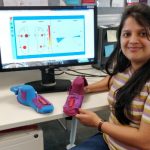 Telemedicine is becoming more commonly deployed, but a problem remains that the technology is very hands off. In certain fields this might be ok, but in healthcare, it represents a significant hurdle, especially for tactile fields such as physiotherapy.
Telemedicine is becoming more commonly deployed, but a problem remains that the technology is very hands off. In certain fields this might be ok, but in healthcare, it represents a significant hurdle, especially for tactile fields such as physiotherapy.
Researchers from the University of Melbourne have developed ‘smart socks’ that they believe can overcome these challenges, providing physiotherapists with real-time information on the lower body movements of the patient.
The work, which was documented in a recently published paper, aims to provide physiotherapists with data on the patient’s movement remotely, something that has traditionally been missing from video consultations.
“What was lacking in video consultations was the ability to observe the subtle differences in patients’ lower limb movements, such as shifts in weight distribution and range of foot movements,” the researcher says. “This meant that physiotherapists had limited understanding of the patient’s actual recovery, leading to less specific treatment. The physiotherapists were also reluctant to try out new exercises with the patients over video.”
Smart socks
The socks, called SoPhy, contain three sensors that capture a range of information about the wearer, including weight distribution, range of movement and even foot orientation. The socks are connected to a web-interface to display the information to the physio.
The idea is that the socks are worn during video consultations to provide the physio with detailed information whilst the patient performs various exercises.
The socks have been tested at the Royal Children’s Hospital, and resulted in increased confidence among physios that the video assessments were effective. They also provided real-time feedback to users, so were popular among the patients as well.
“They got a better understanding of what they should be doing instead of what they were doing, which made the therapy goals simpler and more achievable for them,” the researcher explains.
Effective consultations
Interestingly, the data allowed the phsio to correct their own assessments if they’d been led astray by the visual cues provided by the patient. This allowed them to effectively adapt the exercises performed by the patient.
“Often, without realizing it, patients will apply different tricks to not bear weight on the injured leg, such as pushing through their toes or heels,” the researcher says. “These movements are so subtle that they can be missed by the naked eye, even in a face-to-face consultation. The SoPhy visualization clearly highlights whether the patient is bearing any weight on the injured leg and in which parts, such as in the front, side or on the heels of the foot.”
Suffice to say, the aim isn’t to replace face-to-face consultations entirely, but rather offer the ability to improve the kind of remote consultations that are increasingly common, especially for patients with mobility issues.
It’s an interesting technology, and you can see it in action via the short video below.